|
|
|
Sort Order |
|
|
|
Items / Page
|
|
|
|
|
|
|
| Srl | Item |
| 1 |
ID:
130002
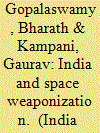

|
|
|
|
|
| Publication |
2014.
|
| Summary/Abstract |
Since China tested a Kinetic-Energy Anti-Satellite (KE-ASAT) weapon in 2007, evidence has surfaced that India may have initiated a similar program. This article makes an anticipatory policy intervention against the development of KE-ASAT weapons. It presents data to show that space debris, and not KE-ASAT weapons, pose the highest risk for the safe operation of Indian satellites. It models a KE-ASAT weapons exchange between India and China in three different scenarios to demonstrate that use of such weapons even on a limited scale would produce an exponential increase in space debris. The latter would threaten the safe operation of satellites for all countries concerned. These data suggest that the concept of deterrence as understood in conventional and nuclear spheres is not easily transportable to the domain of space weapons, which threaten the physical destruction of satellites. If weaponization of space becomes inevitable, policy makers would be better off investing in weapons that disable but do not physically destroy satellites.
|
|
|
|
|
|
|
|
|
|
|
|
|
|
|
|
| 2 |
ID:
130007
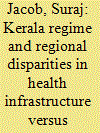

|
|
|
|
|
| Publication |
2014.
|
| Summary/Abstract |
Conventional wisdom holds that although at the time of Kerala state formation in 1956 the northern region (Malabar) lagged behind the southern region (Travancore-Cochin) in development indicators, inter-regional disparities reduced considerably in ensuing decades. The reduction in regional disparities is typically attributed to modern Kerala's welfare policy regime, which emphasized greater growth of infrastructure facilities in Malabar. This study presents evidence for health that suggests that while disparities in outcomes reduced over time, disparities in key infrastructural inputs did not reduce. These differing trends for infrastructure and outcomes are consistentwith a diminishing returns argument that may have little to do directly with the Kerala regime. Rather, the potency of the Kerala regime lays in its ability to increase development inputs throughout the state (albeit without favoring the lagging region) and consolidate the conditions for "public action" to effectively demand and utilize these inputs.
|
|
|
|
|
|
|
|
|
|
|
|
|
|
|
|
| 3 |
ID:
129996
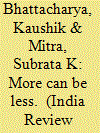

|
|
|
|
|
| Publication |
2014.
|
| Summary/Abstract |
A large number of candidates has become a regular feature of Indian elections. Given the regulatory concerns the problem has evoked, this article reviews the process of candidate entry in select developed countries. The review reveals the presence of diverse approaches, ruling out the necessity for extreme options like debarring fringe candidates-a course suggested by several Indian expert groups. Among various policy options, India had largely relied on electoral deposit. Our results suggest that an increase in deposits had a significant negative impact on candidate entry in India. However, for an effective deterrence, India needs to continue to keep deposits at a very high level compared to the current international benchmark, discriminating political participation of genuinely underprivileged groups. In contrast, the current level of signature requirements, a relatively unused policy tool in India, was found to be too low and could be easily increased further in order to be effective. We argue that given the high variation and lack of stability in candidate structure across regions and over time, a local approach on signature requirements-as in the U.S. -could be an effective deterrent in India. Accordingly, we suggest that the Election Commission of India should not only have the power to determine the deposit before each election; it should also have the power to change the minimum signature requirement across constituencies (subject to some standard checks and balances).
|
|
|
|
|
|
|
|
|
|
|
|
|
|
|
|
| 4 |
ID:
130010
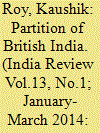

|
|
|
|
|
| Publication |
2014.
|
| Summary/Abstract |
The Partition of the British Indian Empire in the summer of 1947 was a watershed in British-Imperial as well as South Asian history. From the imperial perspective, the British Empire lost much of its luster after the loss of its jewel in the crown. From the perspectives of the inhabitants of the Indian subcontinent, several millions died in the ensuing Partition riots and the mass migrations following the division of British India into two new sovereign countries: India and Pakistan. Today American, British, Indian, Pakistani, and to a lesser extent Bangladeshi scholars continue to debate various aspects of the Partition of India.
|
|
|
|
|
|
|
|
|
|
|
|
|
|
|
|
| 5 |
ID:
129994
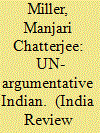

|
|
|
|
|
| Publication |
2014.
|
| Summary/Abstract |
While India is internationally acknowledged as a rising power, there is a surprising lack of responsive ideas and discussion about India's rise within the country. This stands in sharp contrast to China, the other rising power, where domestic discussions of China's rise are expansive and broad ranging, and often seek to shape international perceptions of China. This article argues that India does not respond to international discourse about its rise as prolifically as China because of the benign content of international ideas about its changing status, as well as a statist domestic structure that is resistant to ideational diffusion.
|
|
|
|
|
|
|
|
|
|
|
|
|
|
|
|
|
|
|
|
|